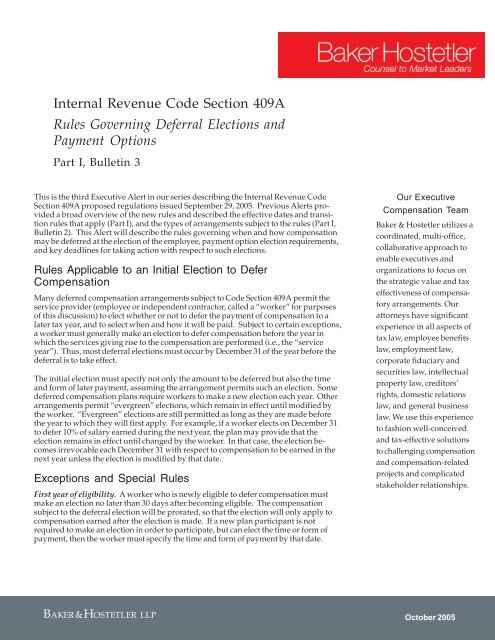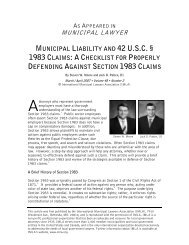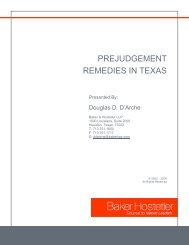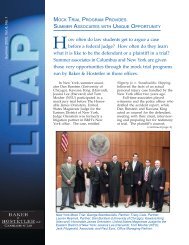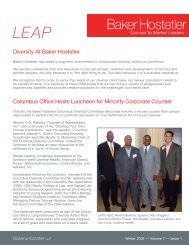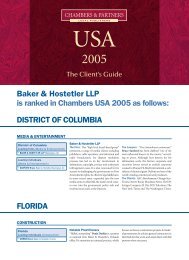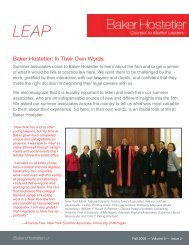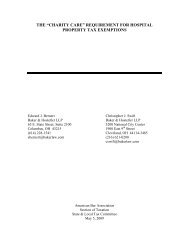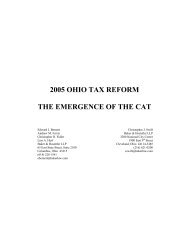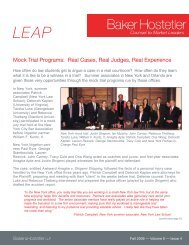Rules Governing Deferral Elections and Payment Options - Baker ...
Rules Governing Deferral Elections and Payment Options - Baker ...
Rules Governing Deferral Elections and Payment Options - Baker ...
You also want an ePaper? Increase the reach of your titles
YUMPU automatically turns print PDFs into web optimized ePapers that Google loves.
Internal Revenue Code Section 409A<strong>Rules</strong> <strong>Governing</strong> <strong>Deferral</strong> <strong>Elections</strong> <strong>and</strong><strong>Payment</strong> <strong>Options</strong>Part I, Bulletin 3This is the third Executive Alert in our series describing the Internal Revenue CodeSection 409A proposed regulations issued September 29, 2005. Previous Alerts provideda broad overview of the new rules <strong>and</strong> described the effective dates <strong>and</strong> transitionrules that apply (Part I), <strong>and</strong> the types of arrangements subject to the rules (Part I,Bulletin 2). This Alert will describe the rules governing when <strong>and</strong> how compensationmay be deferred at the election of the employee, payment option election requirements,<strong>and</strong> key deadlines for taking action with respect to such elections.<strong>Rules</strong> Applicable to an Initial Election to DeferCompensationMany deferred compensation arrangements subject to Code Section 409A permit theservice provider (employee or independent contractor, called a “worker” for purposesof this discussion) to elect whether or not to defer the payment of compensation to alater tax year, <strong>and</strong> to select when <strong>and</strong> how it will be paid. Subject to certain exceptions,a worker must generally make an election to defer compensation before the year inwhich the services giving rise to the compensation are performed (i.e., the “serviceyear”). Thus, most deferral elections must occur by December 31 of the year before thedeferral is to take effect.The initial election must specify not only the amount to be deferred but also the time<strong>and</strong> form of later payment, assuming the arrangement permits such an election. Somedeferred compensation plans require workers to make a new election each year. Otherarrangements permit “evergreen” elections, which remain in effect until modified bythe worker. “Evergreen” elections are still permitted as long as they are made beforethe year to which they will first apply. For example, if a worker elects on December 31to defer 10% of salary earned during the next year, the plan may provide that theelection remains in effect until changed by the worker. In that case, the election becomesirrevocable each December 31 with respect to compensation to be earned in thenext year unless the election is modified by that date.Exceptions <strong>and</strong> Special <strong>Rules</strong>First year of eligibility. A worker who is newly eligible to defer compensation mustmake an election no later than 30 days after becoming eligible. The compensationsubject to the deferral election will be prorated, so that the election will only apply tocompensation earned after the election is made. If a new plan participant is notrequired to make an election in order to participate, but can elect the time or form ofpayment, then the worker must specify the time <strong>and</strong> form of payment by that date.Our ExecutiveCompensation Team<strong>Baker</strong> & Hostetler utilizes acoordinated, multi-office,collaborative approach toenable executives <strong>and</strong>organizations to focus onthe strategic value <strong>and</strong> taxeffectiveness of compensatoryarrangements. Ourattorneys have significantexperience in all aspects oftax law, employee benefitslaw, employment law,corporate fiduciary <strong>and</strong>securities law, intellectualproperty law, creditors’rights, domestic relationslaw, <strong>and</strong> general businesslaw. We use this experienceto fashion well-conceived<strong>and</strong> tax-effective solutionsto challenging compensation<strong>and</strong> compensation-relatedprojects <strong>and</strong> complicatedstakeholder relationships.BAKER&HOSTETLER LLPOctober 2005
BAKER & HOSTETLER LLPPerformance-based compensation. In general, compensationis performance-based if it is contingent on meetingpre-established organizational or individual performancegoals over a performance period of 12 months ormore. The initial election to defer performance-basedcompensation must be made no later than six monthsbefore the end of the performance period. In addition, theworker must perform services continuously from at leastthe date on which the performance criteria are establishedthrough the date on which the initial election ismade. Furthermore, no election to defer may be madeafter the compensation has become substantially certainto be paid <strong>and</strong> the amount is readily ascertainable.<strong>Deferral</strong> of fiscal year compensation. If the servicerecipient (referred to as the “employer” here) uses a fiscalyear other than the calendar year, an election to defercompensation that is based on <strong>and</strong> tied to that fiscal yearmay generally be made before the start of the fiscal year.This option is available only for compensation paid afterthe close of the fiscal year(s) during which it is earned. Ifthe performance period covers more than one fiscal year,the election must be made before the first fiscal yearinvolved.Commissions. The service year is deemed to be thetaxable year of the worker in which commission incomeis received. Thus, the initial election to defer commissionincome must be made before the year in which thecommission is to be received. The worker is treated asperforming the services related to renewal commissions(i.e., commissions payable upon receipt of customerpremiums attributable to retained business) in the taxableyear in which the customer pays the additional premium.Final payroll period. Unless the plan provides otherwise,the general rule is that compensation for a payroll periodthat straddles two years (i.e., payable after the last day ofthe service year, but that relates to a pay period thatbegan in the service year) is treated as compensation forservices performed in the subsequent service year. Thisrule does not apply to an amount paid during the finalpay period that relates to services performed during anyperiod other than the final payroll period, such as anannual bonus. An arrangement may be amended byDecember 31, 2006 to provide for differing treatment ofthe compensation (i.e., to deem the final pay amounts torelate to the year in which the pay period began). Ifadopted after December 31, 2006, such an amendmentcannot take effect for 12 months.Non-elective arrangements. Where an arrangementprovides for the deferral of compensation but does notpermit the worker to elect the time or form of payment, orboth, the arrangement must specify the time <strong>and</strong>/or formof payment, as necessary, by the time the worker first hasa legally binding right to the compensation.Forfeitable rights. A worker’s right to compensation isforfeitable if there is a legally binding right to a paymentin a subsequent year, but the worker must provideservices for 12 or more months following the date whenthe right is obtained. For example, restricted stock unitsoften are subject to a requirement that the worker continueto perform services for at least 12 months. To accommodatethe award of such rights mid-year, the initial electionto defer such compensation may be made by the 30 th dayafter the worker obtains a legally binding right to thepayment, provided it is at least 12 months before theearliest date on which the compensation becomes vested.Subsequent Changes in Time or Formof <strong>Payment</strong>In general. A subsequent election to delay payment <strong>and</strong>/or change the form of payment cannot become effective forat least 12 months, <strong>and</strong> must delay the first payment forat least five years from the date on which it wouldotherwise have been made. In addition, subsequentelections with respect to payments to be made at aspecified time or pursuant to a specified schedule must bemade at least 12 months before the first such amount wasscheduled to be paid. <strong>Payment</strong>s made due to disability,death, or unforeseeable emergency are not subject to thesegeneral rules. The new regulations clarify whetheramounts paid in installments are to be treated as one ormore than one payment under these rules.Installment payments. For this purpose, “installmentpayments” must be part of a series of substantially equalperiodic payments that are paid over a predeterminedperiod of years, but are not paid for life. A deferredcompensation plan may treat installment payments aseither the right to a single payment, or the right to a seriesof separate payments. If the installment right is treated asa single payment, the worker can elect to receive theinstallments in a lump sum if the election is made at least12 months before the payments were to commence, <strong>and</strong>the lump sum is paid at least five years after the originalpayment date. If the installment right is treated as a rightto separate payments, the worker may make a separate
Executive Alertelection with respect to each payment if the election ismade at least 12 months before each respective installmentis payable <strong>and</strong> the election further defers thatpayment for five years. The administrative complexityinvolved with treating each installment as a separatepayment potentially subject to a further deferral electionmay make this somewhat liberal option impractical. Ifthe plan does not specify whether installments will betreated as the right to a series of separate payments, thedefault is to treat the installments as the right to a singlepayment.Annuities. The right to a life annuity is also treated as theright to a single payment. Thus, a worker may elect tochange from an annuity to a lump sum if the election ismade at least 12 months before the annuity paymentswere scheduled to begin, <strong>and</strong> payment of the lump sumis delayed five years beyond the date on which annuitypayments were to begin. A change in the form of apayment from one type of life annuity to another equivalentannuity form before the first annuity payment is dueto be paid is not treated as a subsequent election tochange the form of payment.Multiple payment events. A plan may provide for thepayment of benefits upon the occurrence of two or morepotential permissible payment events (e.g., the earlier of afixed date or separation from service). If multiple paymentevents are specified, the subsequent election rulesapply separately to each payment due upon each paymentevent. For example, if a worker initially elects alump sum payable at the earlier of age 65 or terminationof employment, then the plan may permit the worker toelect to receive the lump sum at the earlier of terminationof employment or age 70 if the election is made no laterthan the worker’s 64 th birthday.New deferral election after election is cancelled due tounforeseeable emergency. A Section 401(k) plan thatpermits hardship distributions must require the participantto cancel elective deferrals to any nonqualifieddeferred compensation plan. Similarly, a nonqualifieddeferred compensation plan that permits distributionsdue to “unforeseeable emergency” 1 may not do so if theemergency could be alleviated by cancellation of adeferral election. A nonqualified plan may cancel adeferral election if necessary for the worker to obtain ahardship distribution under a 401(k) plan, or a distributionunder the nonqualified deferred compensation pl<strong>and</strong>ue to unforeseeable emergency. If the worker later isable to participate again, his or her election will betreated as an initial election.Practical ImplicationsWhile the proposed regulations do not contain manysurprises relative to deferral <strong>and</strong> payment elections, theyare helpful in several respects. First, the ability to treatinstallment payments as a single payment enables aworker to change from installments as the selected formof payment to a lump sum, if offered, without violatingthe anti-acceleration provisions of the new rules. Thereis still a “price” for such an election, however, in therequirement to delay the date of payment by five years.Second, the ability to change current payment electionsthrough the extended period of December 31, 2006,without any required payment delay gives workers thetime they need to reconsider their existing electionchoices without any penalty. Finally, the rules providehelpful flexibility by permitting different elections fordifferent payment events. Employers will need todetermine which of these options they can readilyadminister, then amend their plans <strong>and</strong> communicatethose options to their workers before the end of thetransition period on December 31, 2006.Action NeededNotice 2005-1, issued in December of 2004, is generallystill effective until the proposed regulations becomeeffective. Notice 2005-1 generally permitted initialdeferral elections relating to services performed on orbefore December 31, 2005 to be made through March 15,2005. In addition, Notice 2005-1 permitted cancellationor revocation of deferral elections or termination ofparticipation in a plan adopted before December 31,2005. Under the proposed regulations, to the extent thata plan permitted such elections or changes, they must bedocumented through a plan amendment by December31, 2005.Under the proposed regulations, a plan may be amendedthrough December 31, 2006 to provide for new time <strong>and</strong>payment options, <strong>and</strong> to permit affected participants tomake new elections by that date without application ofthe subsequent election rules. This includes the ability to1The availability of distributions due to unforeseeable emergency will be discussed in a future Alert.
BAKER & HOSTETLER LLPamend a stock right that is a deferral of compensation(e.g., a right at less than fair market value) to provide for(or permit election of) fixed payment terms if the amendment<strong>and</strong> any necessary elections are in place by December31, 2006. In this instance, elections need not be made12 months before they become effective, <strong>and</strong> need notdefer payment for five years from the payment datepreviously specified. The new elections permitted underthe transition rule cannot relate to compensation otherwisepayable in 2006, <strong>and</strong> cannot cause payment of anamount in 2006 that would otherwise be payable in adifferent year.Checklist of Actions Required byDecember 31, 2005:• If new 2005 deferral elections were permitted throughMarch 15, 2005, document the actions (in the mannernecessary for approval of plan amendments under theterms of the plan document) no later than December31, 2005.• If participants have been allowed to cancel deferralelections in 2005, or terminate participation in adeferred compensation arrangement during 2005,document the actions (in the manner necessary forapproval of plan amendments under the terms of theplan document) no later than December 31, 2005.Checklist of Actions Required byDecember 31, 2006:• Amend plans to provide for new time <strong>and</strong> paymentoptions, <strong>and</strong> to permit affected participants to makenew elections, if desired.• Amend arrangements to specify the treatment of finalpay period amounts, if desired. After December 31,2006, such amendments may not be effective for 12months from the date the amendment is enacted.Absent an amendment, final pay period amounts willbe treated as compensation for services rendered in thetaxable year in which the pay period ends for arrangementsin effect before December 31, 2006 (whetherwritten or unwritten).• Amend plans to specify the treatment of installmentpayments as separate payments, if desired. A planthat does not designate separate payment treatment ofinstallment payments on or before December 31, 2006will be deemed to have designated lump sum treatmentif the plan was in existence as of that date.Please contact any of the following attorneys if you want more information or have questions about this particular Alert:CLEVELANDRichard H. Bamberger (216) 861-7480 rbamberger@bakerlaw.comRaymond M. Malone (216) 861-7879 rmalone@bakerlaw.comRuth Ann Maloney (216) 861-7566 rmaloney@bakerlaw.comJohn J. McGowan, Jr. (216) 861-7475 jmcgowan@bakerlaw.comWilliam M. Toomajian (216) 861-7569 wtoomajian@bakerlaw.comCorinne M. Tyler (216) 861-7382 ctyler@bakerlaw.comCOLUMBUSGeorgeann G. Peters (614) 462-4769 gpeters@bakerlaw.comS<strong>and</strong>ra Parks Faulkner (614) 462-4753 sfaulkner@bakerlaw.comJeanne A. Griffin (614) 462-2696 jgriffin@bakerlaw.com<strong>Baker</strong> & Hostetler LLP Executive Alerts are intended to inform our clients <strong>and</strong> other friends of the Firm about current legal developments of general interest. They shouldnot be construed as legal advice, <strong>and</strong> readers should not act upon the information contained in these publications without professional counsel. The hiring of a lawyer isan important decision that should not be based solely upon advertisements. Before you decide, ask us to send you free written information about our qualifications <strong>and</strong>experience. [Florida Rule 4-7.2(d)]© 2005 <strong>Baker</strong> & Hostetler LLPCincinnati • Clevel<strong>and</strong> • Columbus • Costa Mesa • Denver • Houston • Los Angeles • New York • Orl<strong>and</strong>o • Washington, D.C.International Affiliates: São Paulo, Brazil • Juárez, Mexicowww.bakerlaw.com


